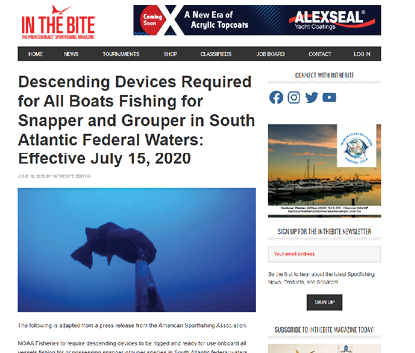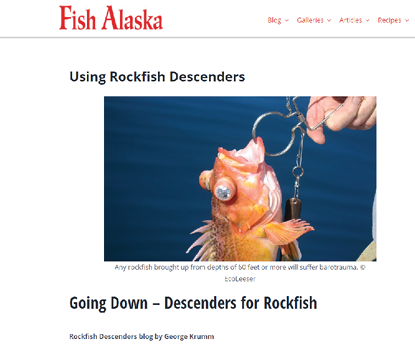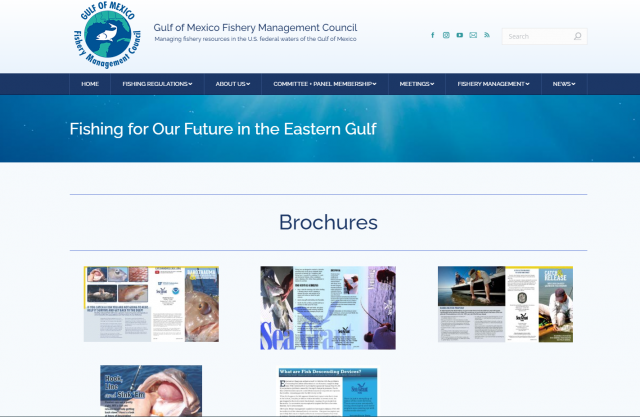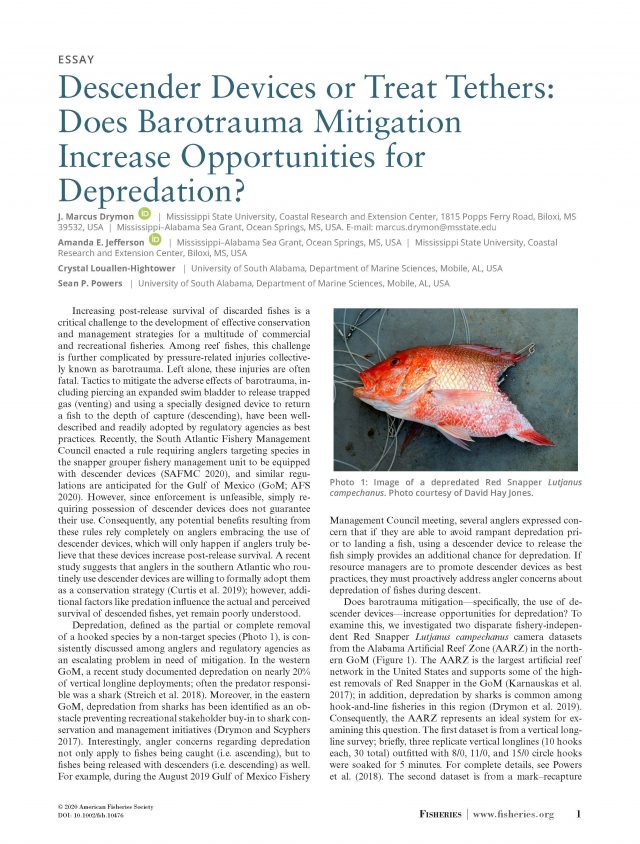Helpful
Resources
Check out some of these resources available on how to help reef fish survive.
NC State CMAST
-
- Red grouper with barotrauma recompressed with SeaQualizer descender device
Hubbard’s Marina
-
- Mitigate barotrauma and help improve our fishery
- Mitigate barotrauma and help improve our fishery
Florida Fish and Wildlife Conservation Commission
-
-
How to treat barotrauma
- How to use a Shelton Fish Descender
- How to use SeaQualizer
-
Center for Sportfishing Science and Conservation
-
-
How to use a SeaQualizer
-
National Oceanic and Atmospheric Administration
-
- Recompression Devices: Helping Anglers Fish Smarter
- Recompression Devices: Helping Anglers Fish Smarter
South Atlantic Fishery Management Council
-
- Down Scope: Saving Snapper and Grouper from Barotrauma
- How to Rig Your Own Descending Device
- Down Scope: Saving Snapper and Grouper from Barotrauma
- Red grouper with barotrauma recompressed with SeaQualizer descender device













Resources for Florida Anglers:
- UF/IFAS Extension and Florida Sea Grant have teamed up with FWC to offer a new Florida Friendly Angler course. This is a FREE online course for both new anglers and experienced fishermen who are looking to up their game.
- Looking for an eco-minded charter captain? Check out the Florida Friendly Fishing Guide Program directory to find a list of certified captains who have taken the time to complete a similar but more extensive program!
- Are you a Florida based for-hire fishing charter? Check out the Florida Friendly Fishing Guide Program to become a certified guide. This online educational program consists of 8 do-at-your-own pace interactive modules covering topics such as best practices for catch and release fishing, fisheries management, environmental ethics, seafood safety and more! Florida Friendly Fishing Guides provide a richer fishing experience for their clients through their angling expertise and their dedication to environmental stewardship. To find more information on the program or to find a certified guide, check out the link above!
- Will a Simple Tutorial Help Anglers Build Up the Red Snapper Population? – North Carolina Sea Grant
- Try this Simple Solutions to Barotrauma in Fish – South Carolina Coastal Resources
- Descending versus venting: Which is better for your fish?
-
What is Barotrauma and What Can Anglers do About it When Releasing Fish?
Supporting Science
Best release practices are based on scientific findings.
Below are some recent publications informing release recommendations.
Awareness, Attitudes, Perceptions, and Use of Best Fishing Practices by Recreational Reef Fish Anglers in the Gulf of Mexico – Gulf States Marine Fisheries Commission, 2022
Summary – Click HERE to view a brief fact sheet:
- 88% help fish return to depth when needed and believe this leads to higher survival.
- The majority of private reef anglers fish in waters deeper than 60 feet, except in FL (42%).
- 71% of private reef anglers are aware of venting.
- 32% of reef anglers are aware of fish descending devices.
- Almost half of all reef anglers that are aware of fish descending devices do not use them or have one on the boat.
- Up to 15% of reef anglers use a venting tool that doesn’t meet regulations.
- 56% of reef anglers primarily get their information from other anglers.
- There are concerns that descending devices contribute to predation/depredation.
Discard Mortality of Red Snapper Released with Descender Devices in the U.S. South Atlantic – Runde et al. 2021
Summary:
- 44 red snapper were tagged with electronic transmitters in 120ft of water off of North Carolina.
- Red snapper were released near the seafloor with SeaQualizer, a descender device.
- The tags reported depth and location within a 0.2 mi^2 area.
- Movements of released-alive red snapper were compared to movements of known-dead and recaptured (known-alive) red snapper to determine survival.
- Statistical simulations accounting for hook type (circle vs J) and associated hooking injury found that ~87 percent of all red snapper would survive if released with descender devices.
Effectiveness of descending devices to mitigate the effects of barotrauma among rockfishes (Sebastes spp.) in California recreational fisheries – Bellquist et al. 2019
Summary:
- Conducted 24 commercial passenger fishing vessel charters at 11 sites and allowed recreational anglers to use 5 different types of descending devices.
- All fish were released to 46m (150’) or to bottom, whichever was shallower.
- Initial post-release mortality was low at 7.5 percent for depths up to 100m and 16.4 percent for capture depths from 100-130m.
- Results suggest rockfishes should be released at least halfway or all the way to the bottom.
- Angler preference for SeaQualizers which had the lowest error rate.
Effectiveness of Venting and Descender Devices at Increasing Rates of Post Release Survival of Black Sea Bass – Rudershausen et al. 2019
Summary:
- 1,748 black sea bass were tagged with t-bar tags off North Carolina.
- Fish were released with one of four methods, in rotation: 1) no treatment; 2) venting with 11-ga cannula; 3) venting with 16-ga needle; and 4) descending to the seafloor with a Blacktip descender device.
- The average increase in survival as compared to fish that were not treated was 48 percent, 51 percent, and 51 percent for the cannula, needle, and descender respectively.
- It is possible to injure a fish with venting, though when applied correctly it can be as effective as descending.
- Barotrauma mitigation via venting or descending results in greatly improved survival of black sea bass.
Quantifying Delayed Mortality from Barotrauma Impairment in Discarded Red Snapper Using Acoustic Telemetry – Curtis et al. 2015
Summary:
- 111 red snapper were tagged with acoustic transmitters over three seasonal trials to assess delayed mortality after release.
- Fish were released with three treatments: non-vented, vented and descended.
- Survival was highest in cooler months and shallower depths.
- Overall survival across all treatments was 72 percent with 15 percent immediate mortality and 13 percent delayed mortality.
- Descended fish were 3 times more likely to survive than non-vented fish and 1.5 times more likely to survive than vented fish.
Venting and Reef Fish Survival: Perceptions and Participation Rates among Recreational Anglers in the Northern Gulf of Mexico – Scyphers et al. 2013
Summary:
- 604 recreational and tournament anglers were surveyed to understand the popularity and perceived effectiveness of venting fish.
- Approximately 2/3 of anglers vent the fish they release offshore and most perceive it to be effective for improving survival.
- Fishing experience did not influence knowledge of proper venting techniques.
- Misinformation on how to properly vent was common among anglers of all experiences.
- Education and outreach programs are necessary to alter or improve venting practices.
Depredation of Demersal Reef Fishes Released with Descender Devices is Uncommon off North Carolina, USA – Runde et al. 2022
Summary:
- Descender devices are increasingly recognized as a leading means of barotrauma mitigation for released reef fishes.
- Anglers often think that predators will feed on fish while being descended.
- Data was synthesized for over 1200 descending device drops of 16 species of reef fish off North Carolina.
- Of 114 videos, we observed possible predators on seven, none of which showed actual depredation.
- Of 1,176 videoed releases, we lost zero descender devices, indicating that, although cryptic depredation may have occurred, equipment loss was nonexistent.
- Our data suggest that when descender devices are used, most or all of this predation occurs after the fish is released from the device and therefore does not constitute depredation.
Descender Devices or Treat Tethers: Does Barotrauma Mitigation Increase Opportunities for Depredation? – Drymon et al. 2020
Summary:
- Two fishery-independent red snapper camera datasets from the Alabama Artificial Reef Zone (AARZ) were used to assess whether descending devices increase depredation opportunities.
- Between 2016 and 2018, GoPro footage was collected from 1,483 vertical longline sets and 1,096 descender releases.
- During vertical longline sampling, 69 depredation events occurred, mostly by sharks followed by dolphins.
- No depredation events were recorded by sharks or dolphins on any of the descender releases.
- Conclusion: Depredation is a problem for ascending fish, but less so for fishes attached to descending devices.
Recreational Angler Attitudes and Perceptions Regarding the Use of Descending Devices in Southeast Reef Fish Fisheries – Curtis et al. 2019
Summary:
- Surveyed 538 recreational anglers (84 percent private, 15 percent charter, 1 percent headboat) regarding use of fish descending devices in the Gulf and South Atlantic.
- 72 percent of respondents had little to no knowledge of descending devices prior to the study.
- 70 percent indicated a preference for descending over venting after provided SeaQualizers.
- 76 percent were likely to continue employing the device.
2017 FWC Citizen Science Descending Device Study Final Report
Summary:
- Screening surveys were sent out in June of 2017 and most anglers indicated they did not own a descending device.
- 634 descending devices were mailed out in early July of 2017.
- The SeaQualizer descending device was the most used and the highest rated in terms of satisfaction followed by the Fish Saver, RokLees, and Shelton Fish Descender.
- Most anglers believed devices were successful at descending fish “nearly 100 percent of the time” and “very effective” at increasing survival rates of reef fish suffering from barotrauma.
- Most anglers thought descending devices were easy to use, were likely to continue to use them, and would recommend other anglers to purchase them.
Venting or Rapid Recompression Increase Survival and Improve Recovery of Red Snapper with Barotrauma – Drumhiller et al. 2014
Summary:
- Red snapper survival was assessed in the lab using hyperbaric chambers.
- Capture events were simulated from pressures corresponding to 30m (~100ft.) and 60m (~200 ft.).
- Fish in vented-surface released and rapid recompression treatment groups had the highest survival.
- Both venting and rapid recompression have the potential to increase red snapper survival.

















